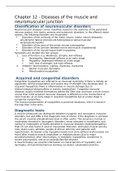Chapter 12 - Diseases of the muscle and
neuromuscular junction
Classification of neuromuscular disorders
Neuromuscular diseases can be classified, based on the anatomy of the peripheral
nervous system, into motor, sensory and autonomic disorders. In the efferent motor
system, the following disorders are recognized:
Disorders of the cell body of the motor neuron (motor neuron diseases):
amyotrophic lateral sclerosis (ALS)/progressive spinal muscular
atrophy/poliomyelitis
Disorders of the axon of the motor neuron (neuropathy)
Disorders of the junction between nerve and muscle (myasthenia)
Disorders of the muscle tissue itself (myopathy)
Symptoms are divided into two groups:
1. Loss of function: e.g. Weakness, atrophy, low reflexes
a. Neuropathy: depressed reflexes at an early stage
b. Myopathy: depressed reflexes at a late stage
c. ALS: loss of strength, but high reflexes
2. Irritation: fasciculations, cramps, myotonia, myokymia
a. Becker muscular dystrophy
b. Mitochondrial myopathies
Acquired and congenital disorders
Congenital myopathies are referred to as muscular dystrophy if there is initially an
apparently normal presentation and severe loss of strength only develops later. In
acquired myopathies there is inflammation or muscle damage due to
endocrinological abnormalities or toxicity (medication). Congenita muscular
diseases usually manifest themselves before the 30th year and have a more chronic
course than most acquired muscular diseases. A difference is the involvement of
neck muscles; at an early stage in acquired myopathies but at a later stage in
congenital myopathies.
The classical presentation of myopathies is proximal weakness, which is worse in
the legs than in the arms.
Diagnostic tests
A muscle ultrasound can distinguish between myogenic and neurogenic muscular
disorders, but and EMG is first diagnostic test of choice. If the diagnosis is unknown
the serum creatine phosphokinase level is often useful. This enzyme is normal or
moderately elevated in neurogenic disorders, never elevated in myasthenia, and
normal or moderately or highly elevated in muscular diseases (dystrophinopathy).
High CK can also found in case of myocardial infarction, strenuous muscle activity,
men, statin users, athletes, people of African ethnicity and patients with
hypertension. Increased urine myoglobin levels (red urine without erythrocytes) are
found after massive muscle breakdown or rhabdomyolysis (due to major
wounds/ischemia), after intoxications, in metabolic myopathies, sometimes in
severe polymyositis, and as an episodic/familial disorder.
A muscle biopsy can provide information on characteristics of myopathy and
dystrophy; immunohistochemical staining can detect cytoskeletal proteins;
, biochemical staining can reveal metabolic abnormalities. Electron microscopy can
reveal mitochondrial and congenital myopathies.
Congenital muscular diseases
Dystrophinopathy
Dystrophin deficiency is due to a gene mutation on the short arm of the X
chromosome; inheritance is X-linked recessive. Duchenne muscular dystrophy
causes delayed motor development, gradually producing a waddling gat with hyper
lordosis. CK levels are very high; but the diagnosis is based on a genetic test or
muscle biopsy.
Physiotherapy can prevent contractures, enabling the patient to remain mobile for
1-5 years longer. Corticosteroids are the only drug treatment that has proved its
effectiveness on Duchenne. Life prospects can be improved by surgical stabilization
of the kyphoscoliosis of the spine.
Over 90% of the carriers have no symptoms, but proximal muscle weakness and
cardiomyopathy may be present.
Very high CK levels are also found in patients with Becker muscular dystrophy. The
difference between Duchenne and Becker is that Duchenne patients have no ability
to produce dystrophin whereas Becker patients can still produce to an some extent.
Facioscapulohumeral muscular dystrophy
There is weakness of the facial muscles (orbicularis oris and orbicularis oculi), which
can be fairly mild and also asymmetrical. Losing the ability to whistle is an early
sign. High note hearing loss occurs in 75% of patients; 60% usually have subclinical
retinopathy. CK activity is normal or slightly elevated. FSH dystrophy is the only
hereditary muscular disorder where the symptoms can be highly asymmetrical.
Myotonic dystrophy
Myotonic dystrophy is a multisystemic disease. Cataract is quite often the first
symptom. The neurological symptoms begin with myotonia of the hand muscles but
can also be noticed in the orbicularis oculi. Weakness and atrophy develop
gradually in the foot extensors, hand extensors and small hand muscles. Slight
symmetrical ptosis (levator palpebrae muscles) also develops, along with weakness
of the other facial muscles (myopathic facies) and pharyngeal muscles.
The penetrance of this disease is variant.
Autosomal dominant inherited proximal myotonic myopathy (PROMM, type 2
muscular dystrophy) is characterized by muscle weakness that is more proximal
and usually less severe.
Limb-girdle dystrophy
Limb-girdle syndromes are a heterogenous group of disorders characterized by
gradually progressive weakness, first of the proximal leg muscles and later of the
trunk muscles and proximal arm muscles. In the autosomal dominant form
cardiomyopathy develops in 50% of cases.
Channelopathies
Channelopathies are congenital diseases caused by impaired function of Na+ and
Cl- channels in the muscles or nerve membrane, which can cause abnormal
discharges. Congenital myotonia is not so much associated with muscle weakness
but does cause distress because it is difficult to start a movement after rest, which
result in substantial motor disability.





